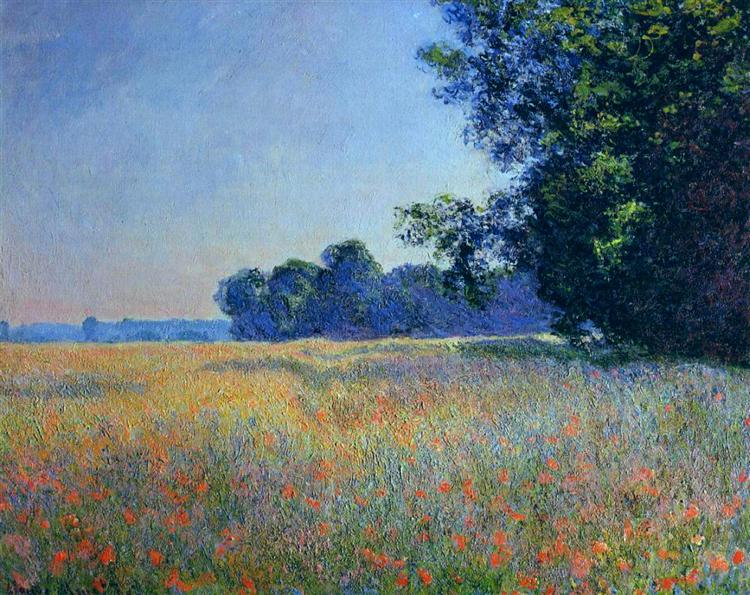Beschreibung
Die Arbeit "Ausa y Amapolas Field - Giverny - 1890" von Claude Monet ist ein prächtiger Exponent des Impressionismus, eine künstlerische Strömung, die mit den Konventionen der akademischen Malerei und auf die Lichtwahrnehmung und die Erfassung des Augenblicks ausfiel. Aus dem ersten Blick strahlt Malerei eine lebendige chromatische Vitalität aus, die Monets Werk kennzeichnet und auch seine tiefe Liebe zur Natur und das ländliche Umfeld von Giverny symbolisiert, wo er einen Großteil seines Lebens lebte.
Die Komposition fällt auf ihre horizontale Anstellung auf, die ein Gefühl der Breite und Integration in die Landschaft vermittelt. Am unteren Rand der Arbeit erstreckt sich ein umfangreiches Hafergebiet bis zum Horizont, unterbrochen durch die lebendige rote Explosion der im Vordergrund wachsen. Dieser Kontrast der Farben zwischen hellgelb und intensiver Rotröttin erinnert an eine Leuchtkraft, die die Essenz der Nachmittagssonne zu erfassen scheint, Hafer aufleuchtet und in Sichtweite eine harmonische Amalgam aus Schatten anbietet. Die Behandlung von Licht ist in diesem Gemälde von grundlegender Bedeutung; Die Art und Weise, wie Monet seine Technik von losen und schnellen Pinselstrichen anwendet, führt zu einer Textur, die zu vibrieren scheint und jedem Blatt und Blütenblatt Leben verleiht.
Wenn der Fortschritt am Boden erzielt wird, wechselt die Palette und lässt sichtbare Blau- und Grüntöne auf einen klaren Himmel und die Abgeschiedenheit der Vegetation hin. Es gibt keine menschlichen Charaktere in der Szene, die es dem Betrachter ermöglichen, in die sensorische Erfahrung der Landschaft vollständig zu tauchen. Monet überträgt jedoch eine tiefe Verbindung mit dem Menschen durch seine Interpretation des Feldes; Jede Brise, die die Spikes streichelt, ist fast spürbar und verwandelt die Landschaft in einen Ort der Kontemplation und Frieden.
Innerhalb der Arbeit bemerken wir die Beherrschung von Monet in der Darstellung von Licht. Die Wahl eines klaren Tages unterstreicht die ständige Wechselwirkung zwischen der Sonne und den Elementen der Natur. Der Monet -Ansatz im vergänglichen - der genaue Moment, in dem das Licht die Szene badet - ist ein bestimmendes Merkmal des Impressionismus sowie die Feier des Lebens in all seiner Vielfalt und Schönheit. Die Arbeiten, obwohl sie 1890 ausgeführt wurde, verkapelt einen fast ätherischen Moment des französischen Sommers, in dem die Zeit zu stoppen scheint und nachdenkend und genießt die Natur einlädt.
"Ausa und Poppy Field - Giverny - 1890" auch Dialoge mit anderen Werken von Monet, wie der Landschaftsserie und seinem berühmten Lilies -Teich. Das kontinuierliche Interesse des Künstlers für das Licht und seine Auswirkung auf die natürliche Umgebung ist ein leitender Faden in seiner Arbeit, das dieses Bild auf erhabene Weise veranschaulicht. Monets Fähigkeit, den Alltag in dauerhafte Kunst zu verwandeln in einem kontinuierlichen Tanz mit Licht.
Zusammenfassend ist "Haferflocken und Mohn - Giverny - 1890" viel mehr als eine einfache Landschaft; Es ist eine Feier von Farbe, Licht und Unmittelbarkeit des Augenblicks. Durch diese Arbeit schafft es Claude Monet, die Essenz eines Augenblicks in der riesigen und sich verändernden Natur zu verkapulieren und uns eine visuelle Zuflucht zu präsentieren, die Reflexion und Bewunderung einlädt. Die Geschichte dieses Gemäldes und Monets Werk im Allgemeinen schwingt weiterhin in der Kunstgeschichte mit und erinnert uns an die unglaubliche Fähigkeit der Kunst, die Schönheit der Welt um uns herum zu erfassen und zu erkunden.
KUADROS ©, eine berühmte Farbe an Ihrer Wand.
Handgefertigte Ölgemälde, mit der Qualität professioneller Künstler und dem unverwechselbaren Siegel von KUADROS ©.
Pictures Reproduction Service mit Zufriedenheitsgarantie. Wenn Sie mit der Nachbildung Ihres Gemäldes nicht vollständig zufrieden sind, erstatten wir Ihr Geld zu 100%.

